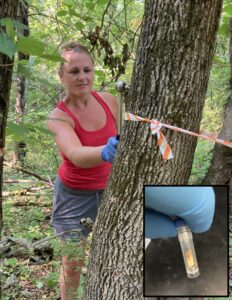Our most recent graduate turned researcher has been published once again, and this time in NeoBiota. In our latest manuscript, Dr. Kathleen Kyle et. al. work to develop a new eDNA sampling technique and describe its efficacy as a detection tool for the invasive pest emerald ash borer (EAB, Agrilus planipennis).

Why/How did we do it?
Ultimately, invasive wood boring species are notoriously difficult to survey as a result of their hidden feeding habits, posing a challenge for locating and managing populations before they reach disastrous levels. In this study we used EAB as a species withprimarily concealed feeding to design a proof of concept environmental DNA (eDNA) tool for detection of wood boring pests. In trees with visual signs of EAB presence, we were able to use an increment hammer to extract core samples that contained DNA deposited by feeding larvae.
What did we find?
The peak in eDNA detection aligned with EAB and tree phenology indicating the ideal time to extract tree cores for this species was late summer when EAB eggs had hatched and larvae were beginning to feed and when deciduous trees such as ash (Fraxinus spp.) start to undergo autumn senescence. Though more work needs to be done to evaluate sampling effort and timing for detection of EAB when populations are at lower abundance, this study provides a promising jumping off point that can be applied not only to EAB detection, but also to a suite of wood boring pests that are problematic on a global scale.
For more details on our methods and results, you can find our publication here.